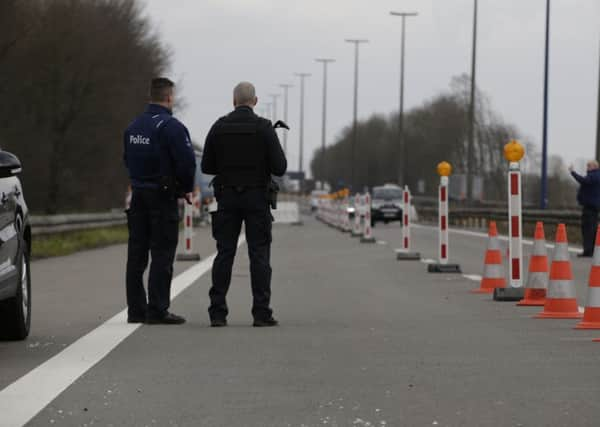Martyn McLaughlin: Brussels atrocity must not spark disproportionate security


Despite the extensive security overhauls introduced in the wake of the 11 September attacks, major airports around the world have wrestled unsuccessfully with their Achilles’ heel, one exposed this morning in devastating fashion; how to guard against an attack in public spaces?
For all that commercial interests have transformed airport concourses into shopping centres, terminal buildings belong to the public, places where emotional farewells and reunions are played out amidst the bustle of the everyday.
Advertisement
Hide AdAdvertisement
Hide AdThe regrettable consequence of this is that these buildings are targets for those who wish to destroy our way of life. The Zaventem bombing is the latest in a long line of attacks that focused on the point of entry at airports.
It may have slipped the minds of many until this morning, but it is only four years since a suicide bombing in the international arrivals hall of Moscow’s Domodedovo airport claimed the lives of 37 people. Before that, we in Scotland reeled in horror at what might have been after Bilal Abdullah and Kafeel Ahmed rammed a Jeep laden with propane canisters into the terminal at Glasgow airport. Finding a way of curbing such murderous intentions while allowing the free movement of passengers has long been a quandary.
As far back as 2002, a shooting at the El Al ticket counter at Los Angeles International Airport in 2002, which killed two people and left four others injured, sparked questions over how - if at all - the vast numbers of people entering terminal buildings might be screened in advance.
The city’s mayor, James Hahn, devised a £6.3bn plan to redevelop one of the largest airports in the world, banning pick ups and drop offs and forcing passengers to pass through security at a dedicated facility a mile east of the terminals, before a train service would usher them to their terminals.
The blueprint, Mr Hahn said, would allow for “concentric rings of security,’’ with the ability to “secure the inner core.” If approved, it would have represented one of the largest public infrastructure projects in US history.
However, a review of the project pointed out an obvious flaw in the strategy devised by Mr Hahn and his army of consultants. Instead of striking at the heart of a terminal building, any terror threat would simply retrain on the new facility, where the highest density of people gather.
This is the conundrum facing the aviation industry and security agencies around the world. No reconfiguration of an airport can adequately prevent a suicide attack at a terminal building. The introduction of a screening system at an airport’s main entrances would only intensify the risk by creating chokepoints with limited points of entry and exit; in other words, the ideal target for a terrorist.
The emphasis to date has been firmly on airside measures, preventing extremists from boarding, or tampering with, commercial aircraft. No system is foolproof, but the existing set up is rigorous. The danger now is that these extensive security procedures are now duplicated at several points across the footprint of major airports around the world.
Advertisement
Hide AdAdvertisement
Hide AdIn the wake of the atrocity in Brussels, there will be a clamour for landside screening at terminal buildings. The suggestions will doubtless look east to the expanded airport perimeter system operated in India, where passengers are only granted access to terminals on production of a ticket and identity documents. Others will point to Israel, where a multilayered security system initially vets passengers outside of terminal buildings.
Indeed, elements of the Israeli approach have favour with the US Transportation Security Administration, the Homeland Security agency established after the 9/11 attacks. It has upwards of 3,000 plain clothes officers trained in “non-intrusive behaviour observation and analysis.” In layman’s terms, they mingle with crowds in busy terminals and look out for suspicious activity.
A delicate balance must be struck between effective profiling and civil liberties, but in reality, this kind of intelligence-led, passenger-focused strategy is the only realistic and reasonable way of preventing another Zaventem. That, at least, is the theory.
Fundamentally, it will only be effective in tandem with a wholesale shift in how we perceive the threat against airports - the terrorists are not targeting airplanes, they are targeting people. Yes, terminals are soft underbellies, but the same, single minded rationale would classify cherished public spaces in our towns and cities as vulnerabilities. No one is demanding we pass through a checkpoint in order to attend a theatre.
There are other, more mundane, considerations to bear in mind here. Airports are businesses, heavily reliant on footfall and commercial enterprise; restricting public access to terminals would not only necessitate a vast capital investment, it would severely restrict the flow of vital revenue.
Only a few hours have passed since the events Brussels but all signs suggest the repercussions will be far reaching. At a time like this, caution and common sense are crucial when angry voices are demanding yet another impenetrable ring of steel. The calls to put in place excessive solutions to an age old problem will grow, but authorities must heed the old military maxim that states he who defends everything defends nothing.
Otherwise, the worst kind of knee jerk bureaucratic response risks granting a small victory to those who seek to destroy our way of life and complicating matters further by displacing the threat elsewhere: to stadiums, office blocks, shopping centres, schools and high streets.
An abomination such as Zaventem sparks the hardest of questions. Sometimes, though, the answers are even more difficult to bear.